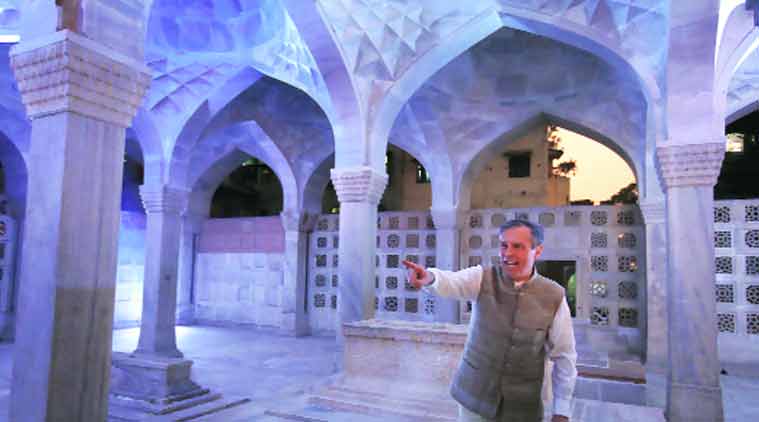- India
- International
Chausath Khamba tomb reopens after four years of painstaking work
A high-definition survey, using 3D laser scanning technology, was carried out on the structure as a precursor to conservation works.
 German Ambassador to India Michael Steiner inaugurates the renovated tomb in Nizamuddin on Sunday. (Source: Express photo by Oinam Anand)
German Ambassador to India Michael Steiner inaugurates the renovated tomb in Nizamuddin on Sunday. (Source: Express photo by Oinam Anand)
With sufi singers singing Amir Khusro’s tunes in the backdrop, Mirza Aziz Koka’s restored tomb was opened to the public after four years of work.
Better known as Chausath Khamba for its 64 pillars, the marble structure stands close to the Hazrat Nizamuddin Auliya’s dargah and Mirza Ghalib’s mausoleum. Over three centuries of damage had caused the monument to lose its shine until the Aga Khan Trust for Culture (AKTC) and the Archaeological Survey of India joined hands with the German Embassy for its restoration.
At the inauguration, German Ambassador to India Michael Steiner said, “Structural influences like the Chausath Khamba are generous gifts of the Muslim community to the diversity of India and Germany wants to contribute to this diversity.” The Ambassador quoted a Ghalib verse and called Chausath Khamba a “masterpiece of Mughal architecture”.
The tomb was built in 1623 for Mughal emperor Akbar’s foster brother Koka. Conservation work began at the structure in 2010 after AKTC engineers found largescale seepage in its 25 domes. “The marble blocks of the domes were tied to each another and embedded in the brick masonry over the domes with iron dowels. The rainwater spouts from the inaccessible roof got blocked and hence, large amounts of water got collected on the roof,” AKTC project director Ratish Nanda said.
“This led to corrosion, rusting and expansion of the iron dowels. The pressure led to bursting of the marble blocks in all parts of the mausoleum — domes, arches, facade, pendentives and even the column capitals — threatening to collapse the structure,” he said.

A high-definition survey, using 3D laser scanning technology, was carried out on the structure as a precursor to conservation works. This was followed with a stone-by-stone assessment of the entire structure to map the profile and defects on each stone.
“The preservation was possible only if the iron dowels could be removed. This required dismantling all the 25 domes. Such an effort had never before been undertaken anywhere in the world,” Nanda explained.
The cracks in brick masonry were reportedly stitched with similar material and lime grout from the roof above used to fill inaccessible portions. Stone carvers, using traditional tools and building techniques, took eight months to successfully repair the first dome — on the northwest corner — thus establishing the repair methodology for the mausoleum. Three teams of stone craftsmen took four years to repair the 25 domes.
Apr 25: Latest News
- 01
- 02
- 03
- 04
- 05































